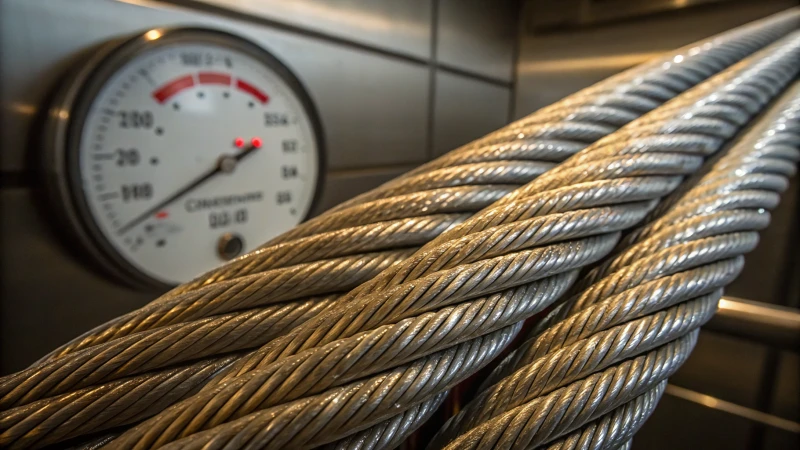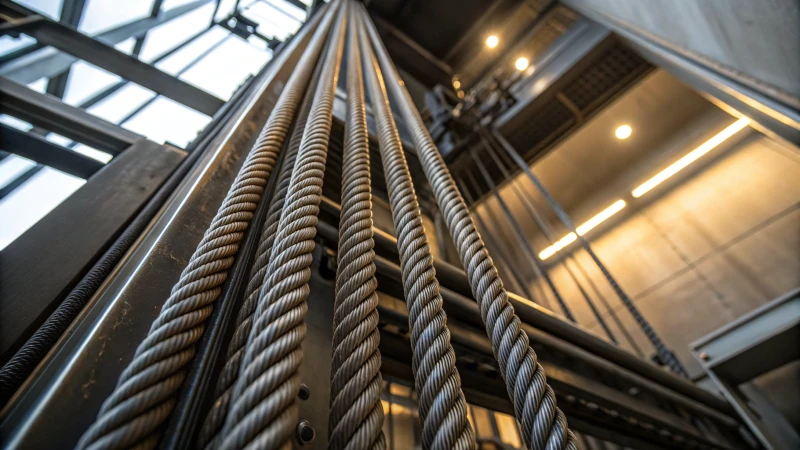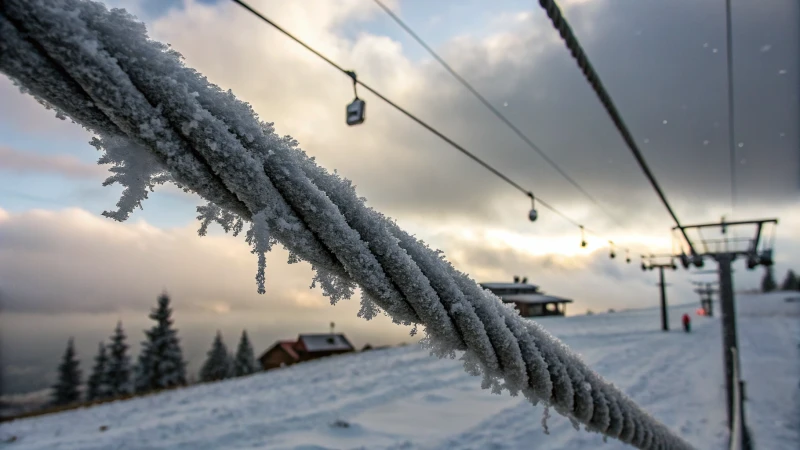
Ever wondered how something as simple as temperature could throw a wrench in elevator operations?
Temperature variations can seriously mess with elevator wire ropes, making them expand and increase tension when it's hot or turn brittle and inflexible in the cold, risking fractures.
I remember once during a chilly winter, stepping into an elevator and hearing a strange creaking sound. It got me thinking about how cold temperatures might affect these steel ropes. Turns out, extreme cold can make them brittle, while hot temps cause expansion and tension. Knowing this helped me appreciate the importance of choosing the right materials and keeping up with maintenance to prevent any mishaps. It's fascinating how such small changes in temperature can have a big impact on safety and efficiency. Exploring material solutions like polymer-coated ropes, which can better handle these extremes, seems like a wise move for anyone managing elevators.
Elevator ropes become brittle in extreme cold.True
Cold temperatures reduce flexibility, increasing brittleness and fracture risk.
High temperatures do not affect elevator rope tension.False
High temperatures cause thermal expansion, increasing rope tension.
How Do High Temperatures Affect Elevator Wire Ropes?
Ever wondered how the hot summer sun might be secretly plotting against your elevator?
When exposed to high temperatures, elevator wire ropes can experience thermal expansion, which increases tension and jeopardizes their performance. High-alloy steel and polymer coatings help counteract these effects by enhancing durability and flexibility, ultimately extending the ropes' lifespan.

The Impact of Thermal Expansion
I remember the first time I realized just how much temperature can impact everyday objects—like the time my car’s metal seatbelt buckle seemed to double as a branding iron on a scorching day. Elevators face similar challenges. The steel in elevator wire ropes is robust, but once temperatures climb past 70°C, it starts to expand. This subtle change can ramp up tension within the ropes, threatening their strength and reliability. It's like giving your friend a gentle hug that accidentally turns into a bone-crushing bear hug—you didn't mean to, but it happened! Understanding these nuances helps ensure elevators run smoothly and safely.
This thermal expansion1 can compromise the rope's tensile strength and overall performance. Operators must understand these dynamics to ensure safe and efficient elevator function.
Enhancing Rope Performance in Heat
To combat the heat, it's all about choosing the right materials. High-alloy steel ropes are like the superhero suits of the elevator world—they're designed to handle extreme heat without breaking a sweat. And if you add polymer coatings, it's like giving them a protective shield. This coating not only insulates but also keeps the rope flexible, extending its life by up to 20% compared to the bare bones of uncoated ropes.
| Rope Type | Temperature Resistance | Flexibility | Lifespan Extension |
|---|---|---|---|
| Uncoated Steel | Moderate | Low | Standard |
| High-Alloy Steel | High | Moderate | Improved |
| Polymer-Coated Steel | Very High | High | Significantly Improved |
Imagine having a pair of shoes that magically adjust to the weather, always keeping your feet comfortable—that’s what these coatings do for wire ropes.
Standards and Safety Protocols
It's all fun and games until someone doesn't follow the rules. That's why complying with standards like ISO 4344 is crucial. These guidelines help in selecting and testing wire ropes to withstand different temperatures. Regular check-ups are like those dental appointments we try to avoid but know we need—catching issues early can save you from bigger problems down the line.
Compliance with standards like ISO 4344 is vital for ensuring that elevator ropes perform well under varying thermal conditions. These standards guide the design, material selection, and testing of wire ropes. Implementing regular inspections and maintenance schedules can help identify potential temperature-induced issues2 early, minimizing safety risks and operational downtime.
Case Study: Application in Extreme Conditions
In some parts of the world, it feels like stepping into an oven when you go outside. In these regions, industries have gotten creative, using synthetic core ropes with metal sheathing to beat the heat. Plus, they've installed temperature sensors to keep tabs on rope conditions in real time.
In regions where temperatures frequently exceed the recommended threshold, industries have turned to innovative solutions such as synthetic core ropes with metal sheathing. This design maintains the rope's strength while significantly enhancing heat resistance.
Moreover, regular monitoring systems equipped with temperature sensors provide real-time data on rope conditions, allowing for proactive maintenance strategies.
Implementing these technologies ensures elevators remain operational even in extreme environments3.
Understanding how high temperatures affect elevator wire ropes is crucial for maintaining safety and functionality. By leveraging advanced materials and adhering to international standards, operators can effectively manage these challenges.
Steel elevator ropes expand at temperatures over 70°C.True
Steel expands when heated, increasing tension and affecting performance.
Polymer-coated ropes extend lifespan by 50% compared to uncoated ropes.False
Polymer coatings extend lifespan by up to 20%, not 50%.
How Does Extreme Cold Affect Elevator Wire Ropes?
When temperatures plummet, elevator wire ropes face a battle against brittleness. Knowing how they fare in the cold is key to keeping things safe and running smoothly.
Extreme cold makes elevator wire ropes brittle, reducing their flexibility and increasing the risk of fractures. Special coatings and materials can help counter these effects, extending rope life and ensuring safety.

The Science Behind Brittle Wire Ropes
Imagine standing outside on a bitterly cold day, feeling the chill seep into your bones. That's what happens to steel wire ropes4 in elevators when temperatures drop below freezing. The steel contracts at a molecular level, becoming stiff and prone to breaking under stress. This isn't just a minor inconvenience—it's a potential safety hazard.
Protective Coatings and Materials
I remember a time when I had to find a solution for wire ropes that were failing every winter. After some research, I discovered polymer-coated ropes. These have become a lifesaver in cold environments, offering up to 20% better performance according to the ISO 4344 standard. High-alloy steel5 ropes are another game-changer, maintaining flexibility even when everything else is frozen solid.
Practical Implications for Safety
For those of us responsible for keeping elevators safe, understanding how temperature affects these materials is crucial. I've learned the hard way that regular inspections can prevent costly and dangerous failures. Establishing a routine check-up system can catch issues early, especially in areas where winters are harsh.
| Temperature | Effect on Ropes | Solution |
|---|---|---|
| Below -10°C | Increased brittleness | Use polymer coatings |
| -10°C to 0°C | Reduced flexibility | High-alloy steel ropes |
These strategies are not just about extending the life of the wire ropes—they're about ensuring safety and reliability. By working closely with suppliers who understand these challenges, we can procure the right materials tailored to our needs. Regular inspections6 are a must, helping us spot problems before they escalate.
Extreme cold causes elevator ropes to become brittle.True
Cold contracts steel's molecular structure, increasing brittleness risk.
Polymer coatings have no effect on rope performance in cold.False
Polymer coatings improve rope performance by up to 20% in cold.
Why Do Polymer-Coated Ropes Excel in Extreme Temperatures?
Have you ever wondered why some ropes can withstand harsh weather better than others?
Polymer-coated ropes excel in extreme temperatures because they resist thermal expansion and contraction. This coating boosts durability, flexibility, and resistance to environmental stressors, significantly extending the rope's lifespan compared to traditional steel ropes.

Understanding the Mechanics of Polymer Coatings
Let me take you back to a time when I first encountered the marvel of polymer-coated ropes. Imagine being on a construction site where temperatures were so high that you could fry an egg on the pavement. The ropes we used then would expand and become dangerously taut, almost snapping under pressure. But polymer-coated ropes? They stayed cool under pressure, thanks to their protective coating that acts like a barrier against thermal expansion7. Even when temperatures soar above 70°C, the steel core inside these ropes remains blissfully unaffected.
On the flip side, picture a winter so harsh that just stepping outside feels like a scene from a survival movie. In such frigid environments, below -10°C, regular steel ropes would become brittle and prone to snapping like dry twigs. But polymer-coated ropes? They remain flexible, bending but never breaking, thanks to their unique ability to adjust to temperature fluctuations without compromising their integrity.
| Temperature | Impact on Steel Ropes | Benefit of Polymer Coating |
|---|---|---|
| Above 70°C | Thermal Expansion | Prevents excessive tension |
| Below -10°C | Brittleness | Maintains flexibility |
The Role of Material Composition
During my journey through this field, I've come to appreciate how much material composition matters. It's not just about the polymer coating; it's about what's beneath it too. High-alloy steel, often the backbone of these ropes, stands resilient against high temperatures. Think of it as a superhero's armor, with the polymer coating providing an extra shield against the villains of moisture and UV radiation.
Manufacturers sometimes mix different polymers to tailor coatings for specific needs. Like choosing between PVC for flexibility or nylon for superior abrasion resistance—each has its own superpower.
Application in Industry
In industries like construction, mining, and logistics, I've seen firsthand how these ropes transform operations. In construction, where projects often stretch across varying climates, these ropes are like trusty companions that stand firm against weather-related disruptions. In mining, they're the silent guardians ensuring safety by reducing the risk of failures due to temperature-induced stress.
The table below captures some industry-specific benefits:
| Industry | Key Benefit of Polymer Coated Ropes |
|---|---|
| Construction | Enhanced durability and safety |
| Mining | Increased lifespan and performance |
| Logistics | Reliability under varying loads |
In conclusion, polymer-coated ropes offer a dynamic solution to managing temperature extremes. Their unique blend of protective coating and robust core materials ensures they're up for the task in critical applications across diverse industries. It's like having a reliable partner who adapts and performs no matter what challenges lie ahead.
Polymer coatings prevent steel rope brittleness below -10°C.True
Polymer coatings maintain flexibility in cold, preventing brittleness.
PVC coatings are used for superior abrasion resistance.False
Nylon, not PVC, offers superior abrasion resistance in ropes.
Why Choose High-Alloy Steel Ropes?
I remember the first time I encountered high-alloy steel ropes on a construction site; their sheer strength was awe-inspiring.
High-alloy steel ropes are renowned for their remarkable durability, superior tensile strength, and resistance to corrosion and extreme temperatures, making them indispensable for high-stress industrial applications where safety and longevity are crucial.

Enhanced Tensile Strength
When I think back to those early days on the job site, I can't help but appreciate how high-alloy steel ropes are engineered to handle intense loads. Adding alloys like chromium, nickel, and molybdenum to these ropes increases their tensile strength, enabling them to withstand extreme tension8 while maintaining flexibility. It's like seeing a seasoned yoga instructor gracefully stretch without breaking a sweat.
Superior Corrosion Resistance
I once worked on a project near the coast, where the salty air corroded everything in sight—except our trusty high-alloy steel ropes. These ropes are crafted to resist corrosion, a must-have feature for operations in corrosive environments such as marine or chemical industries. The alloying elements form a protective layer on the rope surface, preventing oxidation and extending the material's lifespan.
Heat and Cold Resilience
Imagine working on a rooftop in the dead of winter or under a scorching sun. That's when I truly valued the heat and cold resilience of high-alloy steel ropes. Standard steel ropes might expand or become brittle, but these high-alloy variants maintain their properties across a broad temperature range, ensuring consistent performance9 regardless of the weather.
Cost-Benefit Analysis
| Feature | Standard Steel | High-Alloy Steel |
|---|---|---|
| Tensile Strength | Moderate | High |
| Corrosion Resistance | Low | High |
| Temperature Resilience | Limited | Extensive |
| Lifespan | Shorter | Longer |
Applications in Various Industries
- Construction: From cranes to elevators, I've seen these ropes lift incredible loads with ease.
- Mining: They are indispensable for hoisting equipment that faces abrasive conditions underground.
- Marine: On shipbuilding projects, they provide unmatched durability against saltwater corrosion.
- Industrial Manufacturing: Whether dealing with furnaces or freezing conditions, these ropes deliver consistent performance.
Incorporating high-alloy steel ropes significantly enhances operational safety and efficiency across these industries, reducing the need for frequent replacements and maintenance costs. Exploring further10 into these benefits can aid procurement decisions and project planning. It's like having a reliable friend by your side, ready to tackle any challenge.
High-alloy steel ropes have superior tensile strength.True
Alloys like chromium and nickel enhance tensile strength for heavy loads.
Standard steel ropes resist corrosion better than high-alloy ropes.False
High-alloy ropes have elements that form a protective layer against corrosion.
Conclusion
Temperature variations significantly affect elevator wire ropes, causing brittleness in cold and thermal expansion in heat. Polymer-coated and high-alloy steel ropes enhance durability and safety under extreme conditions.
-
Learn how thermal expansion impacts steel wire ropes' structural integrity and safety. ↩
-
Understand common problems caused by temperature fluctuations in elevator wire ropes. ↩
-
Explore strategies for operating elevators safely in extreme temperature conditions. ↩
-
Learn how extreme cold affects the molecular structure of steel, increasing brittleness and fracture risk. ↩
-
Discover why high-alloy steel offers better performance in cold environments, enhancing rope durability. ↩
-
Understand how regular inspections help maintain safety and performance of elevator wire ropes. ↩
-
Explore how polymer coatings mitigate thermal expansion in ropes, enhancing their performance in high-temperature environments. ↩
-
Discover how high-alloy steel ropes maintain strength and flexibility under extreme tension. ↩
-
Learn about the temperature resilience of high-alloy steel ropes for reliable use in harsh climates. ↩
-
Explore further details on how high-alloy steel ropes enhance safety and efficiency in various industries. ↩

